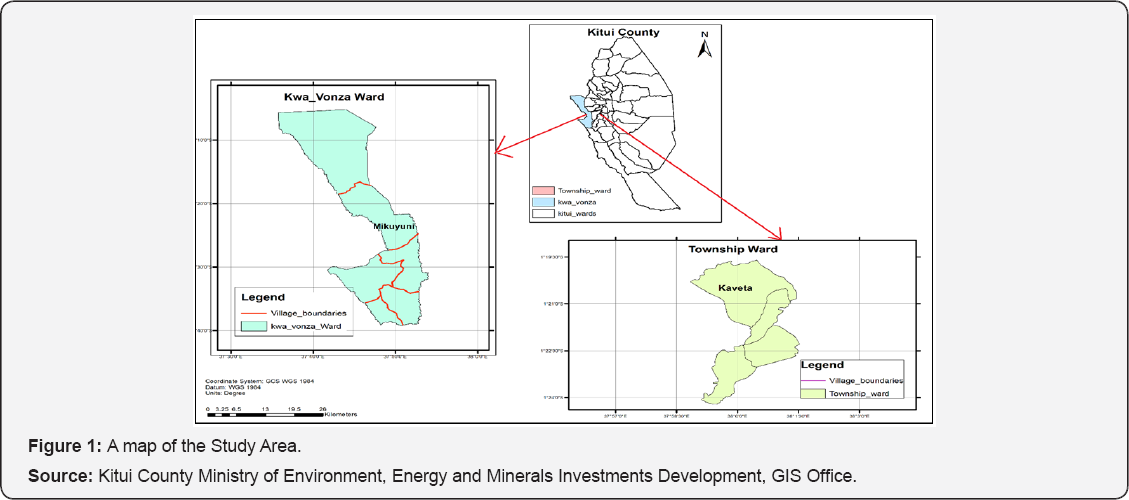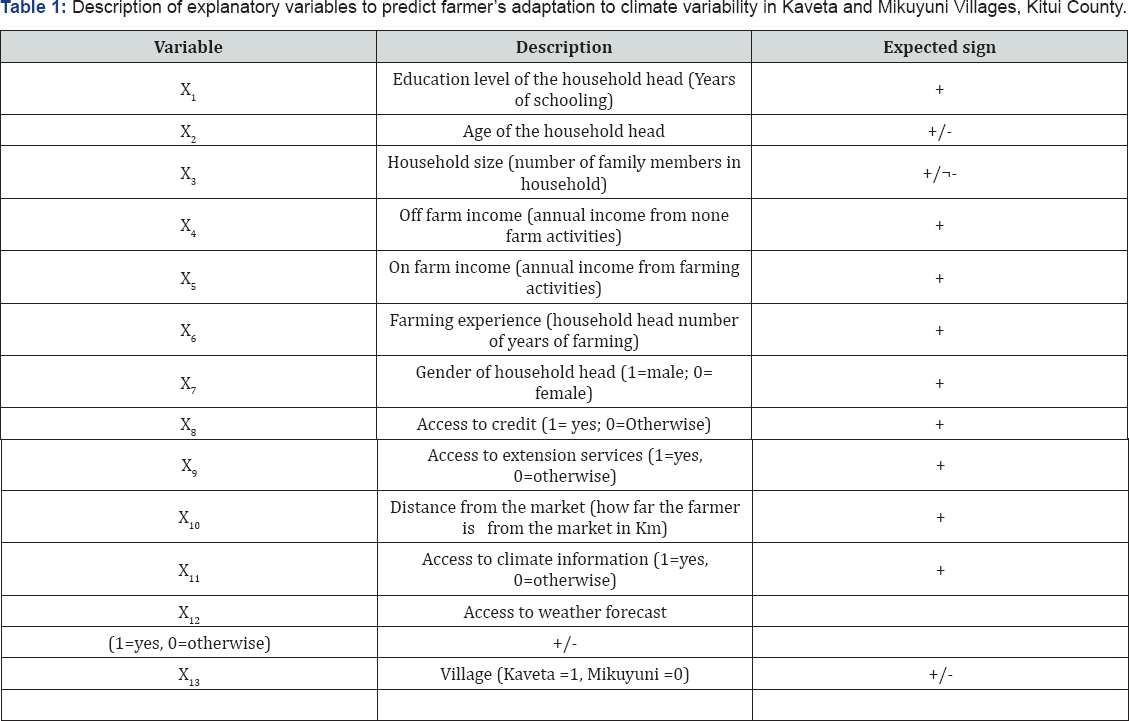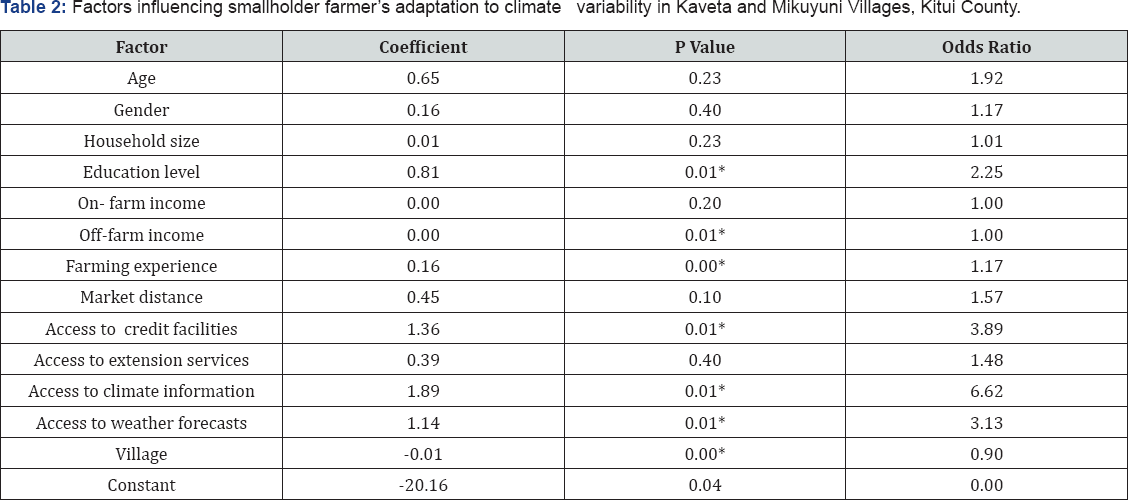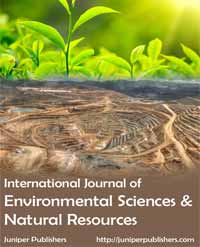Factors Influencing Smallholder Farmers' Adaptation to Climate Variability in Kitui County, Kenya - Juniper Publishers
Juniper Publishers- Open Access Journal of Environmental Sciences & Natural Resources
Factors Influencing Smallholder Farmers' Adaptation to Climate Variability in Kitui County, Kenya
Authored by Mutunga Evelyn J
Abstract
The study was carried out to examine the factors and constraints that influence small farmers' adaptation to climate variability in Kitui County. Descriptive survey design was used. Two villages, Kaveta and Mikuyuni, were purposively selected. A total of 177 households were randomly selected to constitute the study sample. Logit regression model was used to analyze factors influencing farmers' adaptation to climate variability. Results from Logit regression analysis showed that village, education level, farming experience, off- farm income, access to credit facilities, access to climate information and weather forecasts significantly (p<0.05) influenced farmers' adaptation to climate variability in both Kaveta and Mikuyuni villages. While inadequate technological capacity (78.2%), lack of access to credit facilities (72.2%), lack of access to extension services (68%) and high cost of adaptation (66.8%) were the major constraints to adaptation by farmers in Kaveta Village, lack of access to irrigation water (89.6%), lack of labor (86%), high cost of adaptation (81.4%), unreliable weather forecasts (81.4%), inadequate land resources (76.4%) and inadequate financial resources (74%) were the major constraints to the farmers' adaptation in Mikuyuni Village. The study established that farmers in different locations faced different constraints in their efforts to adapt to climate variability. The study therefore recommends that climate variability adaptation policies, programs and projects by government and non-governmental agencies should be guided by local farmers' needs in specific geographic locations.
Keywords: Logit regression; Adaptation strategies; Climate variability; Smallholder farmers
Introduction
Adoption of practices and technologies for adaptation to climate change and variability is crucial for farmers to cope with the changing climate and reduce agricultural losses due to unreliable and erratic rainfall patterns [1]. According to IPCC (2007), implementation of adaptation measures by farmers would be critical in addressing the inevitable impacts of climate change and variability. The success of adaptation strategies by farmers is determined by the adaptive capacity of the farmers as it greatly influences the vulnerability of communities and regions to effects of climate variability. According to Bryant et al. [2], adoption of adaptation strategies in response to the effects of climate variability on agriculture are determined by how farmers' perceptions of climate change and variability are translated into agricultural decisions. Several studies have reported adaptation strategies in agriculture such as diversification of crops, use of hybrid varieties, use of drought resistant crop varieties, changing of planting dates, water harvesting, irrigation, switching from crop farming to livestock keeping and soil conservation measures [3-6].
According to [7], farmer's adaptation to climate change and variability is influenced by several factors. Most research efforts on farmer's adaptation to climate change and variability have been done on a regional scale [7] and very little work has been done on farm and household levels. Therefore, the current study focused on the factors influencing farmers’ adaptation to climate variability on household level in Kaveta and Mikuyuni villages of Kitui County. It sought to examine the factors and constraints influencing smallholder farmers’ adaptation to climate and variability in the selected villages.
Materials and Methods
Profile of the Study Area; Topography and Climate
The study was carried out in Kaveta and Mikuyuni villages in Kitui County (Figure 1). Kitui County lies between 400m to 1,830m above sea level sloping from the west to the east with the highest regions being Kitui Central and Mutitu Hills. Mikuyuni Village lies in the Yatta plateau while Kaveta Village is situated in the Kitui Central region [8]. The climate of the area is semi-arid with very erratic and unreliable rainfall. The area is hot and dry throughout the year with temperatures ranging from a minimum of 14-22° centigrade to a maximum of 26-34° centigrade. The months of February and September are the hottest months in the year. Rainfall is distributed within two seasons yearly and varies from 500-1050mm with about 40% reliability. The long rains are experienced between March and May and short rains between October and December [8]. The soil types range from sedimentary rocks, red sandy soils, to clay black cotton soils which are generally low in fertility [9].

Population and Economy
Mikuyuni Village has a human population of 7,448 persons and 1,528 households while Kaveta Village has a human population of 4,584 persons and 936 households with 90% of the population rural based [10]. Livestock production and crop farming are the back bone of the people's economy in the area contributing to nearly three quarters of household earnings [11]. Cattle, sheep and goats are the most important animals in the area. Various crops such as maize, beans, sorghum, pigeon peas, millet and cassava are cultivated mainly for subsistence while green grams, sweet potatoes, vegetables and fruits (such as mangoes and bananas) are grown for sale [8].
Research Design, Data Collection and Data Analysis
Descriptive survey design was used. Purposive sampling method was used to select the villages while simple random sampling was used to select the households. Analysis of the total annual rainfall for the last 15 years confirmed that there was a statistically significant (t15 =8.34, p<0.05) difference in precipitation in Kaveta (M=416.33, SD=199.64) and Mikuyuni (M=342.54, SD=146.47) villages. The sample size for the study was 177 households (Kaveta= 87 and Mikuyuni=90). Primary data was collected through administration of questionnaires in Kaveta and Mikuyuni villages. The Statistical Package for Social Sciences (SPSS version 20) was used to run both descriptive and inferential statistics. Logit regression model was used to assess the factors determining smallholder farmer's adaptation to climate variability.
The model specification as outlined by Gujarati 2004 and applied by [6] is presented below, albeit in reduced form.

Yi is a dichotomous dependent variable (farmer using any adaptation technology or not, specified as yes=1, otherwise = 0). 0 is the Y- intercept whereas 1- 13 is a set of coefficients to be estimated. X1-X13 are explanatory (intervening) variables hypothesized (Table 1) based on theory and related empirical work, to influence farmers’ adaptation to climate variability.


Result and Discussion
Factors Influencing Smallholder Farmer's Adaptation To Climate Variability In Kaveta And Mikuyuni Villages, Kitui County
The Logit regression results showed that education level, farming experience, off- farm income, access to credit facilities, access to climate information and weather forecasts significantly (p<0.05) influenced farmers' adaptation to climate variability in both Kaveta and Mikuyuni villages. Age and gender of the household head, household size, on-farm income, distance to the market and access to extension services were however not significant (Table 2). The results showed that the gender of the household head did not have a significant (co-efficient=0.16, p=0.40, odds ratio=1.17) influence on farmer’s adaptation to climate variability. The results however showed that households headed by male were 1.17 times likely to adapt to climate variability as compared to female-headed households.

The results are in line with findings by [12,13]who noted that male-headed households are often considered to be more likely to get information about new technologies and take risky businesses than female-headed households and thus are more likely to invest in climate variability adaptation technologies than their female counterparts. The results however contradict findings by [13] who found out that the probability to adapt of the male headed households was lower than that of the female headed households in Kyuso District. The influence of age of the household head was also found to be insignificant on farmer's adaptation to climate variability in both villages (coefficient=0.65; p=0.23, odds ratio=1.92). The odds ratio however implies that a unit increase in age of the household head increased the probability of farmers to adapt to climate variability by a factor of 1.92. The results are in line with findings by [13,14,3] that the probability to adapt to climate change and variability was higher for older farmers as compared to that of younger farmers. The results are however contrary to findings by [1] and who found out that the likelihood of adapta-tion to climate change and variability decreases in older farmers as they generally lack interest and incentive to adapt.
In regard to education level, the results indicated that education level of the household head had a significant (coefficient=0.81; p=0.01, odds ratio=2.25) positive influence on farmer's adaptation to climate variability. The findings indicated that farmers with high education level were more likely to adapt as compared to farmers with low education levels. Similar findings were reported by [6] who observed that higher level of education leads to an increase in the probability of adopting new technologies since it increases one's ability to receive, decode, and understand information relevant to making innovative decisions. In the present study, farming experience was found to have a positive significant (coefficient=0.16; p=0.00, odds ratio=1.17) influence on farmers’ adaptation to climate variability in Kaveta and Mikuyuni villages. The results implied that farmers with more farming experience were 1.17 times likely to adapt to climate variability as compared to farmers with less farming experience.
The results corroborate findings by [6,7,3,15] who indicated that farming experience increases the probability of adoption of climate change and variability adaptation strategies and argued that experienced farmers have better knowledge and information on changes in climatic conditions and crop and livestock management practices. Further, the results showed that the household size in Kaveta and Mikuyuni villages (coefficient=0.01; p=0.23; odds ratio=1.01) did not have significant influence on farmers’ adaptation to climate variability. The odds ratio however showed that a unit increase in family size increased the farmers' probability to adapt by a factor of 1.01. This concurs with findings by [16] that household size is a proxy to labor availability, and thus a larger family size is more likely to adapt since farmers can take up labor intensive adaptation measures.
While on- farm income was not significant (coefficient=0.00, p=0.20, odds ratio=1.15) in predicting farmer's adaptation to climate variability in both villages, off-farm income had a significant positive influence (coefficient=0.00; p=0.01; odds ratio=1.00).This implies that a unit increase in off- farm income increased farmers’ probability to adapt to climate variability by a factor 1.00 in the two villages. The results concur with findings by [6] who noted that off-farm income is more reliable than on farm income since it is not affected by climate change and variability as it is the case with on-farm income and thus more instrumental in influencing the households wealth, thereby enhancing risk bearing capacity of farmers. Similar studies by [1,13] also found a positive relationship between farmers' off-income and their adoption of adaptation strategies to climate change and variability. The results further established that access to credit by farmers in Kaveta and Mikuyuni villages (coefficient=1.36; p=0.01; odds ratio=3.89) had a significant positive influence on farmers probability to adapt to climate variability. This implies that a unit increase in access to credit increases the probability of farmers to adapt by a factor of 3.89. This could be attributed to the fact that availability of credit offsets financial constraints enabling farmers to purchase improved crop varieties, acquire adequate labour for timely planting, purchase facilities for soil fertility management and water conservation as well as irrigation equipment.
The results concur with findings by [17] that there was a positive relationship between the level of adaptation of climate change strategies and availability of credit. Thus, interventions by governments and non-governmental entities that contribute to increased availability and accessibility of credit facilities by small scale farmers in Kaveta and Mikuyuni villages would go a long way in increasing the adaptability to climate variability and by large extend to increased food security. Access to climate information (coefficient=1.89; p=0.01; odds ratio=6.62) had a positive and significant influence on farmers’ adaptation to climate variability in the villages. The results indicated that farmers with access to climate information were 6.62 times more likely to adopt adaptation strategies as compared to farmers without access to climate information.
This is because access to climate information increases farmers' awareness and knowledge on the changing rainfall and temperature patterns as well as the possible climate variability response strategies.
[7,15] noted that awareness and knowledge of precipitation and temperature by farmers is key in climate change and variability adaptation and decision-making process. [18]. Also reported that climate science provides valuable sources of information that can help, not only in predicting future weather and climate, but also in developing understanding and skills in managing uncertainty. In addition, [19] stated that climate- related concerns and information have claimed to be among the major factors considered by farmers in their decision making. The results further showed that access to weather forecasts in Kaveta and Mikuyuni villages had a positive and significant influence (coefficient=1.14; p=0.01; odds ratio=3.13) on farmers probability to adapt to climate variability. The odds ratio implies that farmers with access to weather forecasts were 3.13 times more likely to adapt to the changing precipitation and temperature patterns as compared to farmers without access to weather forecasts.
Weather forecasts information enables farmers to make informed decisions on what crops and crop varieties to plant and when to do timely planting. [19]. Reported that seasonal weather forecasts are crucial for the provision of early warning information to farmers since they give probabilities of different rainfall scenarios which strengthen the adaptive capacities of farmers. In their study, Bryan et al. (2009) also reported accessibility and usefulness of weather information as one factor that affects a farmer's ability to adapt to climate change. In regard to the village (coefficient=-0.01, p= 0.00; odds ratio=0.90) of origin, the results showed that farmers from Mikuyuni Village were more likely to adopt adaptation strategies in response to climate variability than those in Kaveta Village. This is in agreement with findings by [20] that more farmers in Mikuyuni Village had adapted to climate change and variability compared to those in Kaveta Village. This could imply that farmers in the drier areas are more conscious of climate variability and thus more likely to adopt strategies to cope [21-24].
Constraints to Small holder Farmer's Adaptation to Climate Variability in Kaveta and Mikuyuni Villages, Kitui County
Using a scale of 1-5, 5 being the most influential constraint, the farmers in Kaveta Village ranked inadequate technological capacity (78.2%), lack of access to credit facilities (72.2%), lack of access to extension services (68%) and high cost of adaptation (66.8%) as the major constraints to their adaptation to the increasing temperature and changing rainfall patterns as shown in (Table 3). In Mikuyuni Village, lack of access to irrigation water (89.6%), lack of labor (86%), high cost of adaptation (81.4%), unreliable weather forecasts (81.4%), inadequate land resources (76.4%) and inadequate financial resources (74%) were the major constraints to the farmers' adaptation to the increasing temperature and changing rainfall patterns. From the results, it can be deduced that farmers from the two villages had different constraints to climate variability adaptation [25-30].

While inadequate technological capacity, lack of access to credit facilities, lack of access to extension services, and high cost of adaptation were the major constraints to adaptation by farmers in Kaveta Village, lack of access to irrigation water, lack of labor, high cost of adaptation, unreliable weather forecasts, inadequate land resources and inadequate financial resources were the major constraints to the farmers’ adaptation in Mikuyuni Village [31-33]. The difference in constraints to climate variability adaptation observed in the two villages could be attributed to the different farmers' needs in the villages. For example, farmers in Mikuyuni Village would be required to invest more in irrigation, water and soil conservation techniques to cope with the scanty and unreliable rainfall as compared to those in Kaveta Village who received relative higher amounts of rainfall [34-36].
From the results, it can be noted that most of the constraints reported by farmers from both villages are related to financial constraints and inadequate access to climate information. Financial constraints limit farmer’s access to hybrid crop varieties, irrigation equipment, water and soil management facilities and labor. This can be explained by observation in the previous section that off-farm income, access to credit as well as weather forecasts and climate information increased farmers' ability to adapt to climate variability. The results are in line with findings by [1,3,4,6].
Conclusion and Recommendations
The study established that age, household size, education level, farming experience, off- farm income, access to credit facilities, access to climate information and weather forecasts as well as the village of origin significantly influenced farmers’ adaptation to climate variability in both Kaveta and Mikuyuni villages. From the study, it can also be deduced that farmers in the drier areas are more likely to adopt adaptation strategies in response to climate variability compared to those in the wetter areas. The study also concludes that farmers in the wet areas face different constraints in their efforts to adapt to climate variability from their counterparts in the drier areas [37-40]. The study therefore recommends that government and non-governmental agencies should integrate the factors that determine farmers' adaptation to climate variability into climate variability and climate change policies, programs and projects, which should be guided by local farmers’ needs at specific geographic locations [41-43].
For more articles in Juniper Publishers | Open Access Journal of Environmental Sciences & Natural Resources please click on: https://juniperpublishers.com/ijesnr/index.php




Comments
Post a Comment